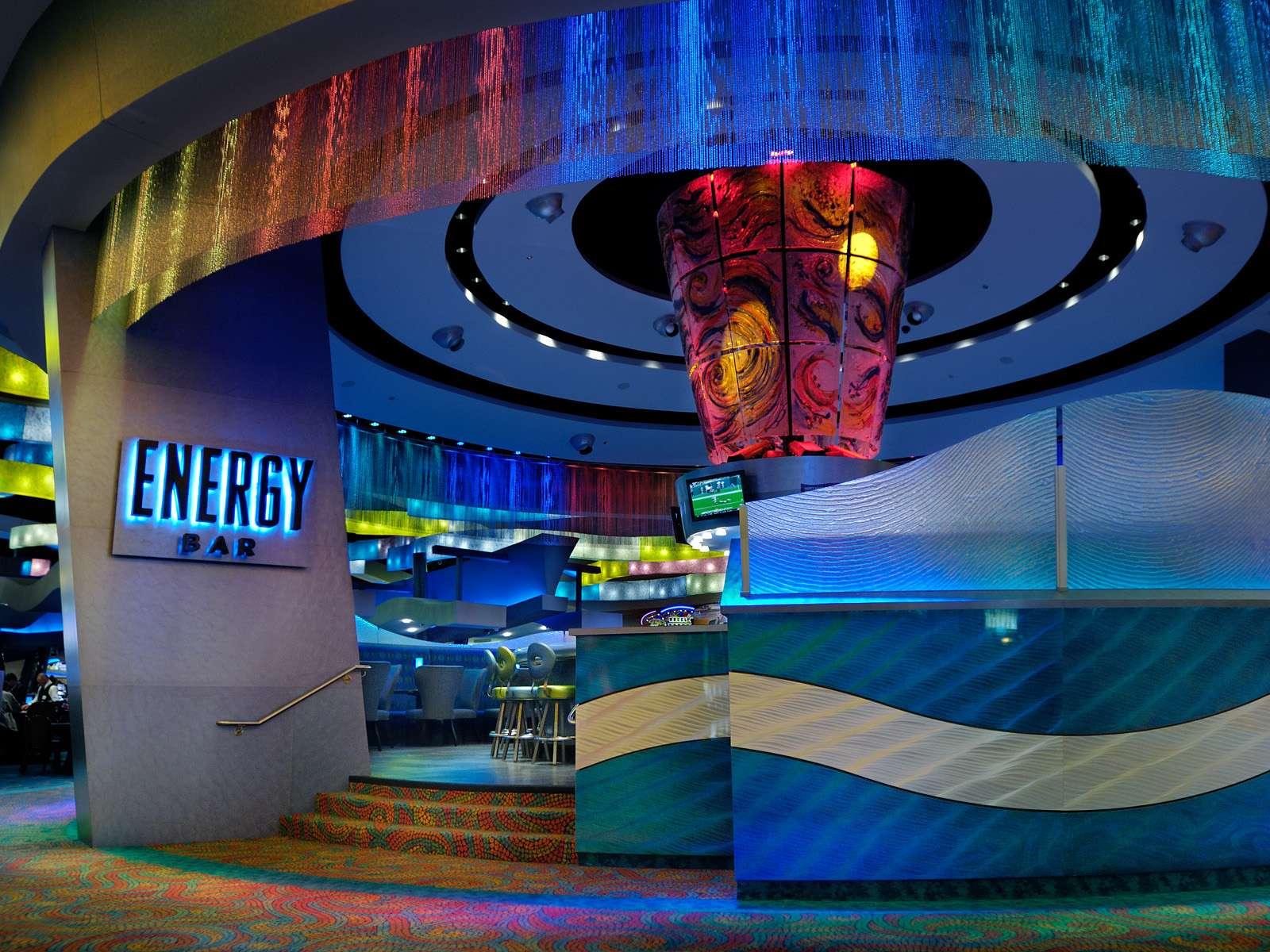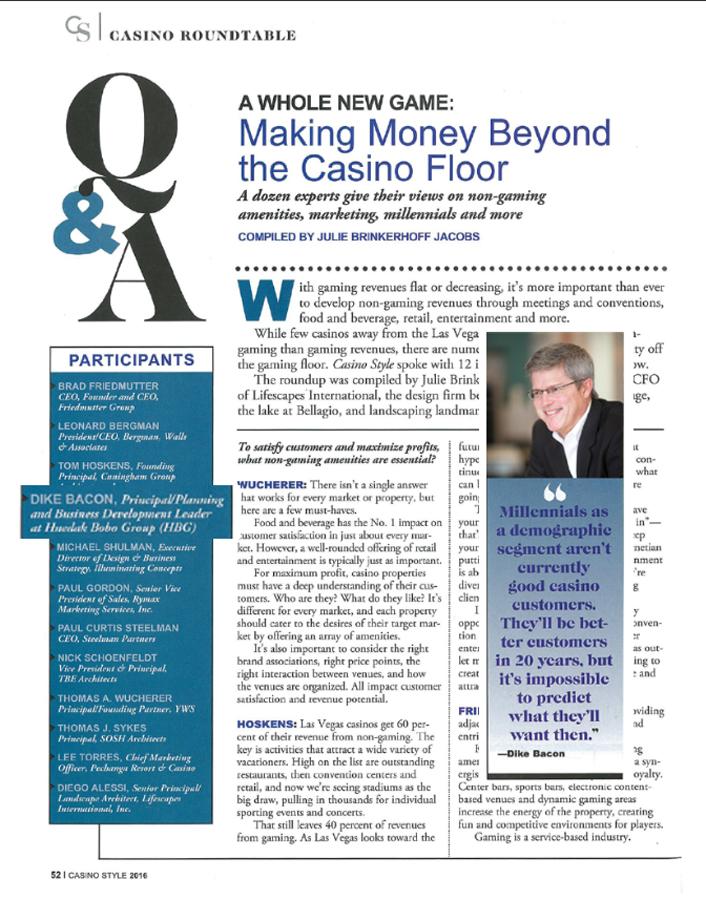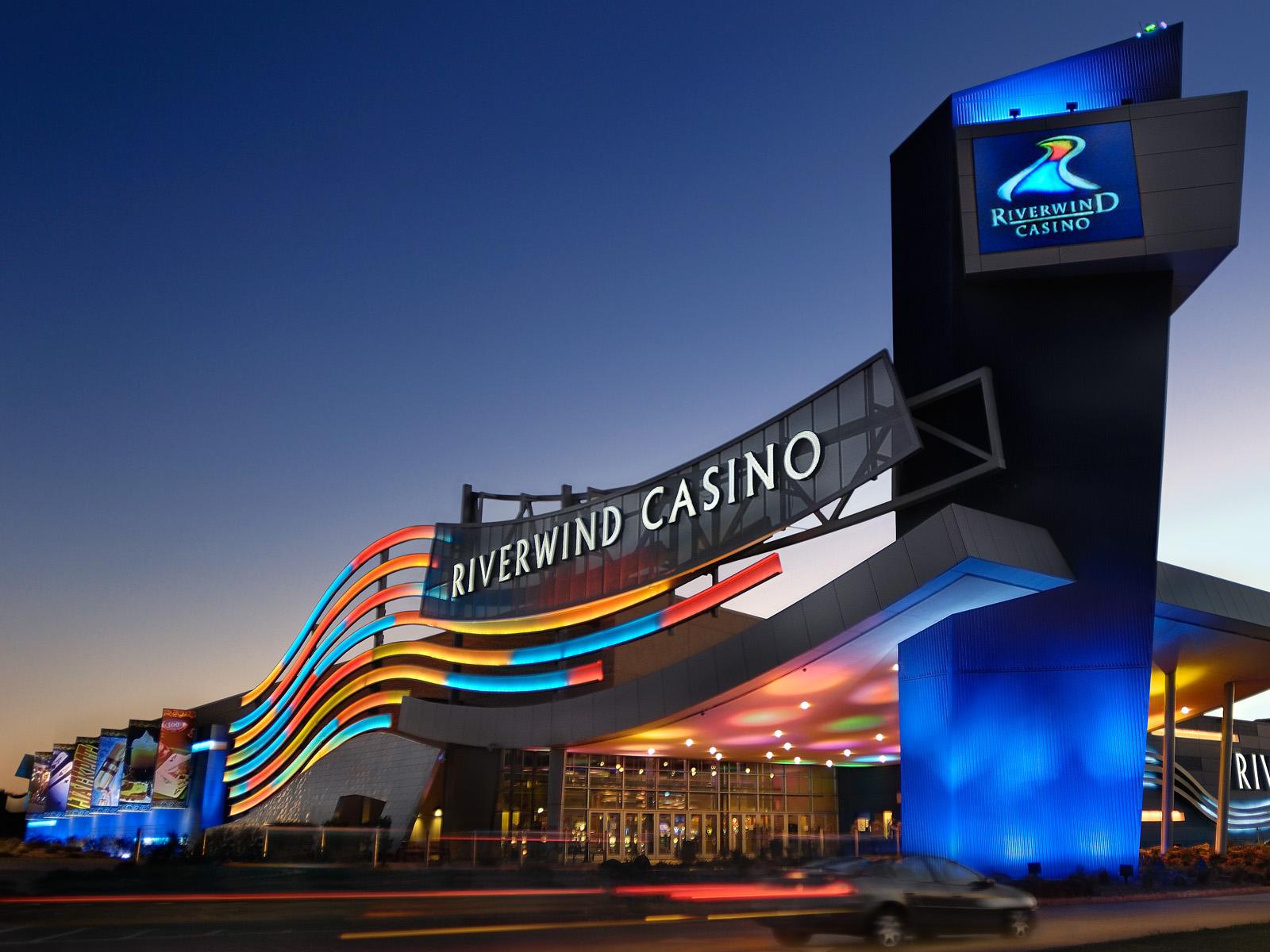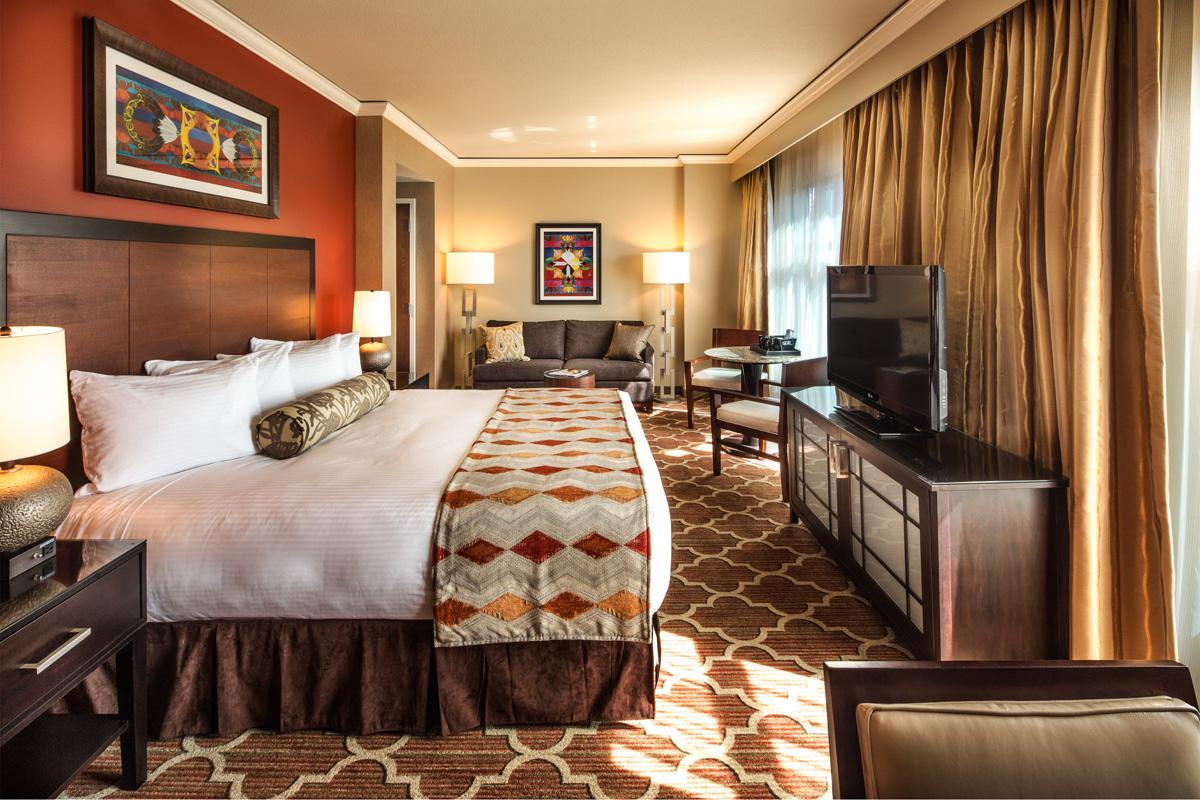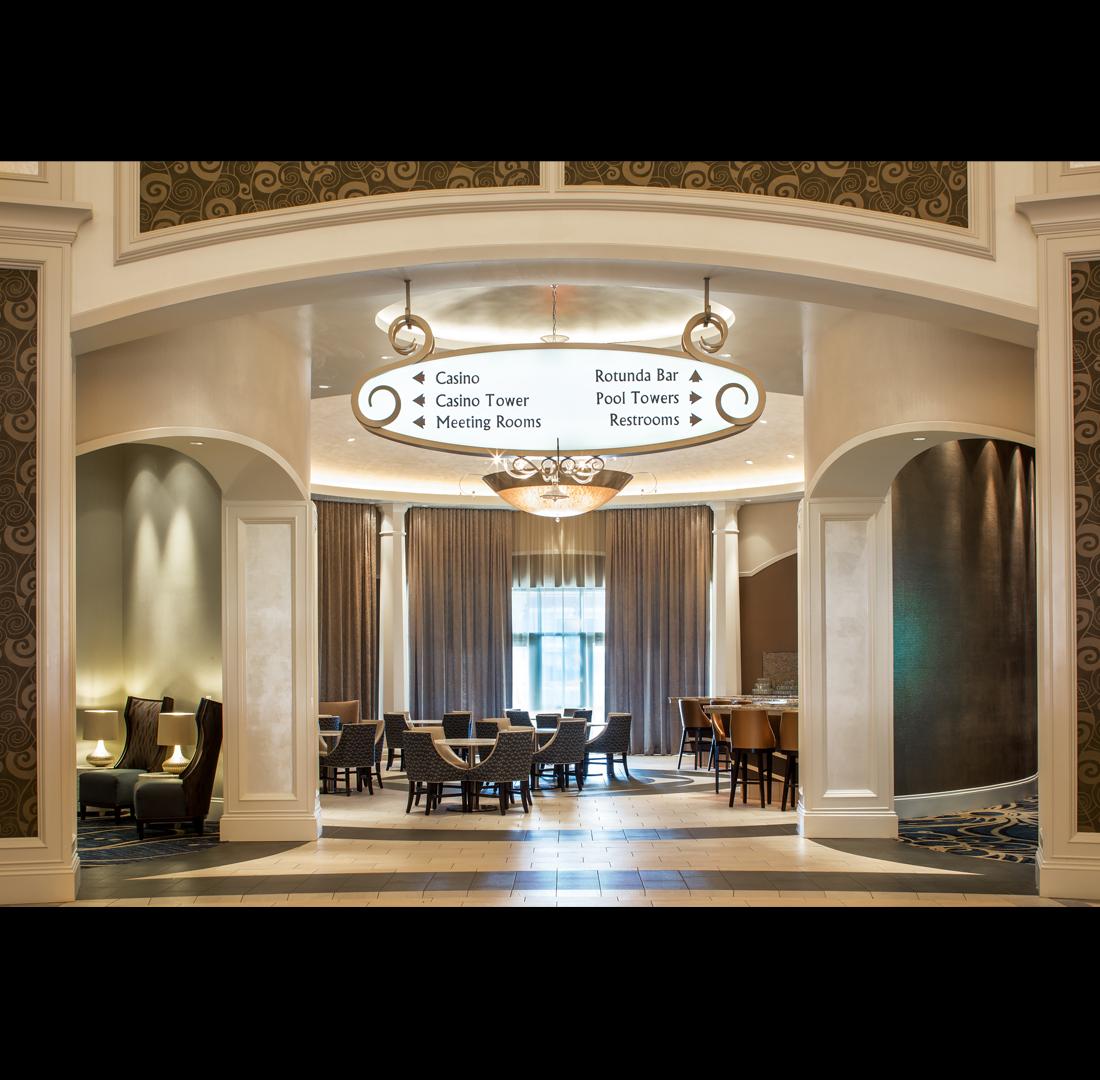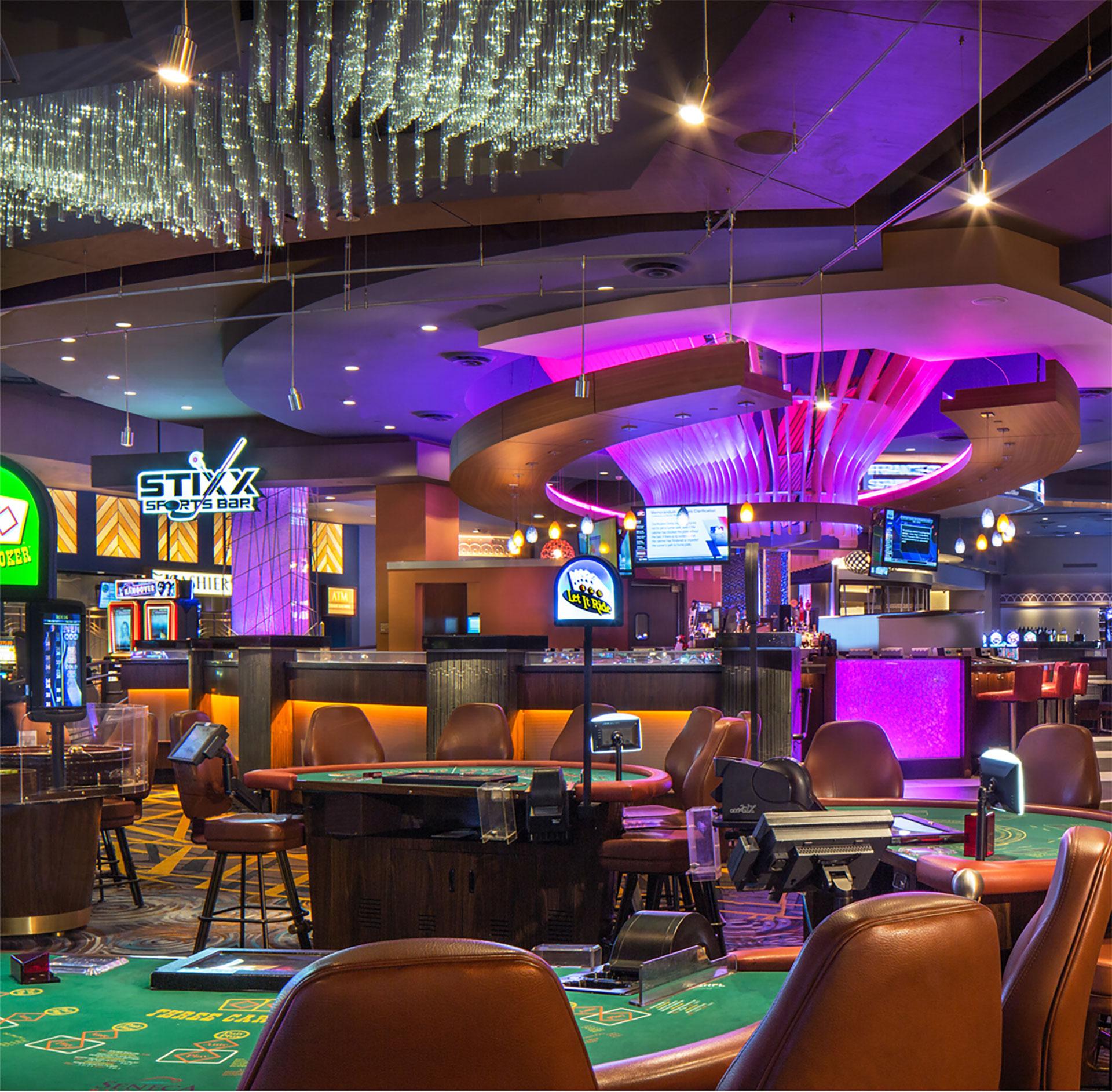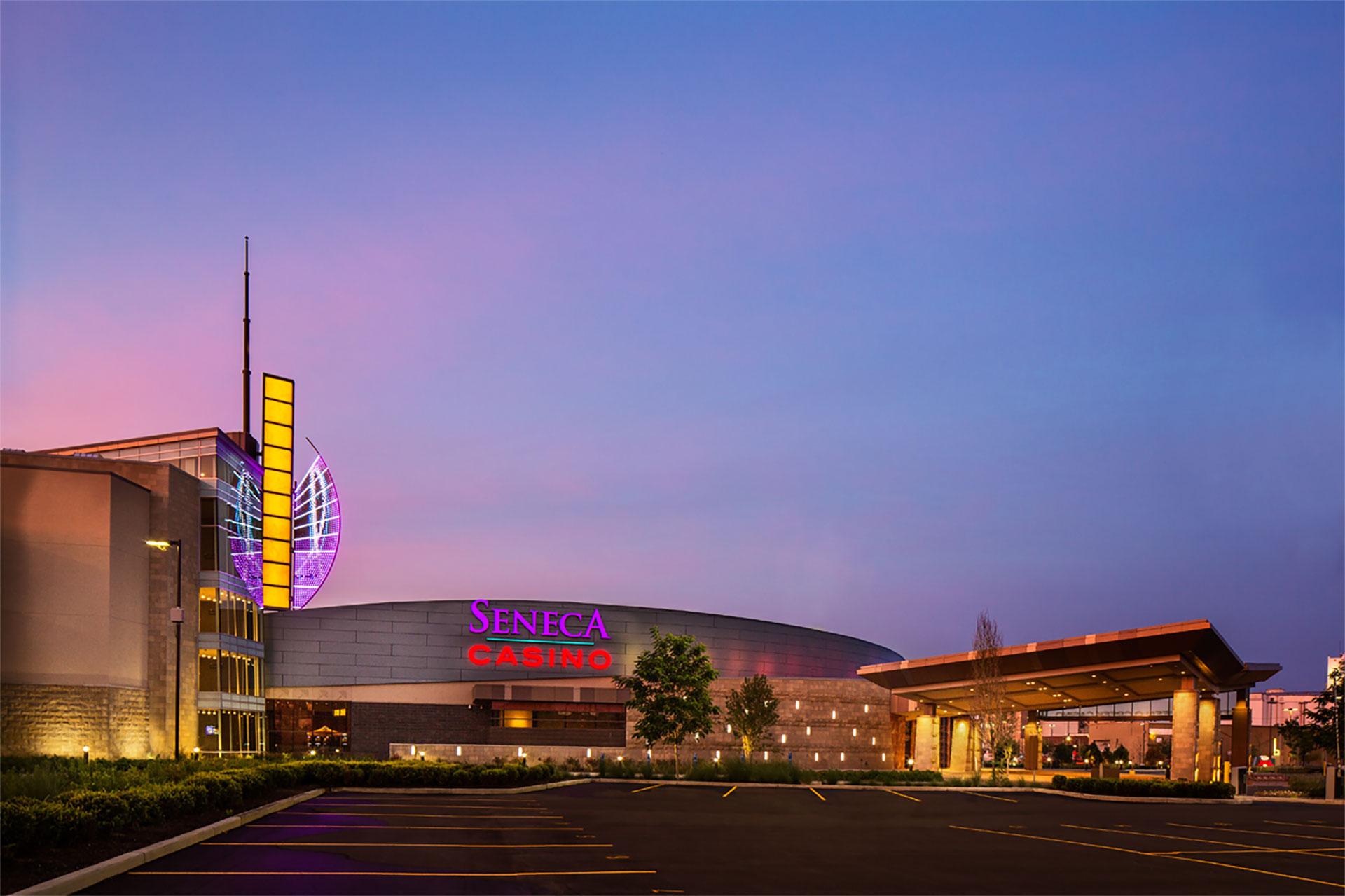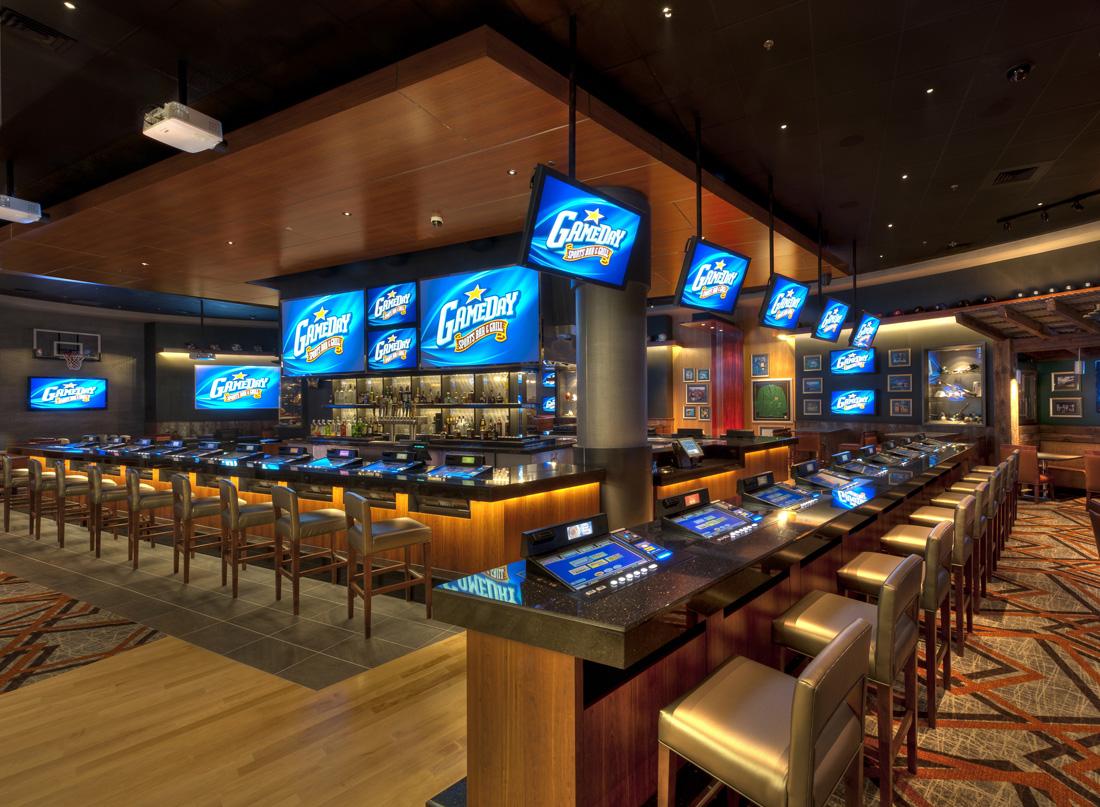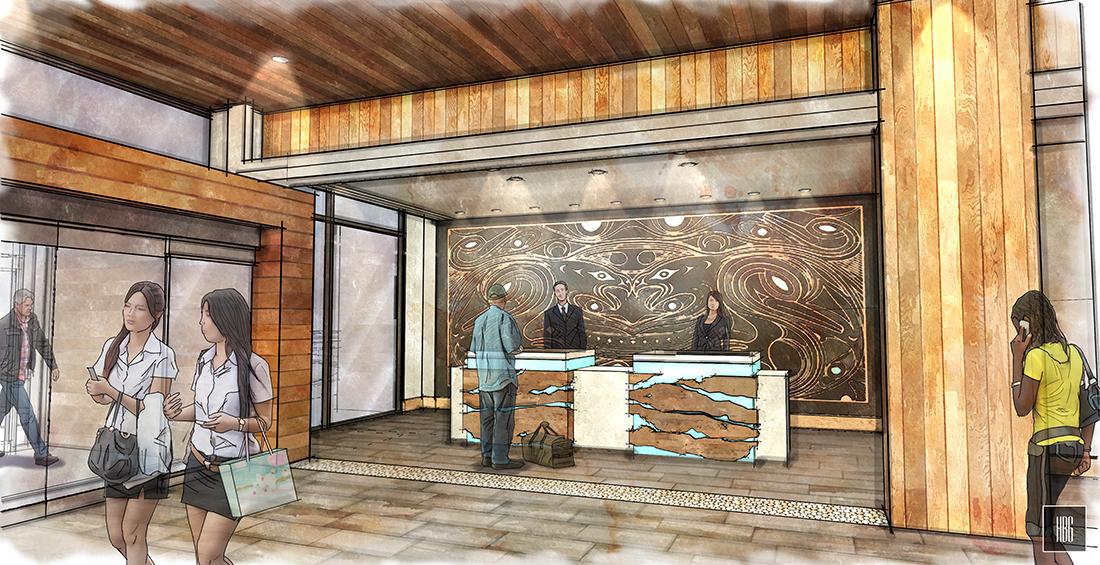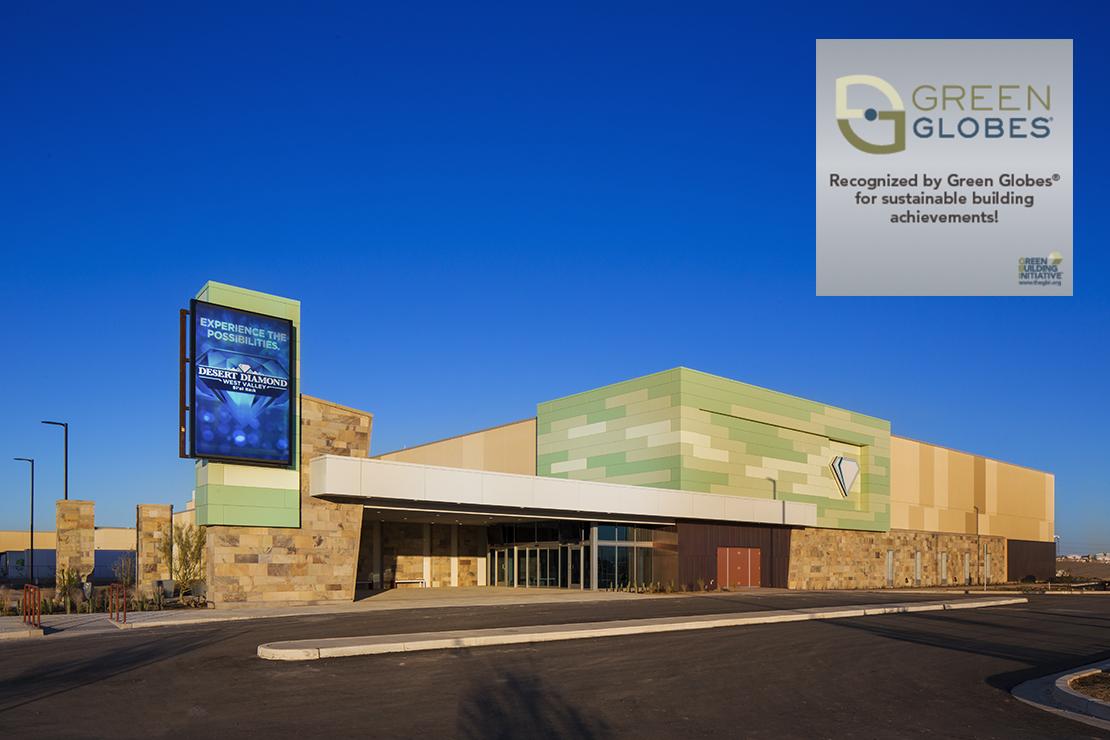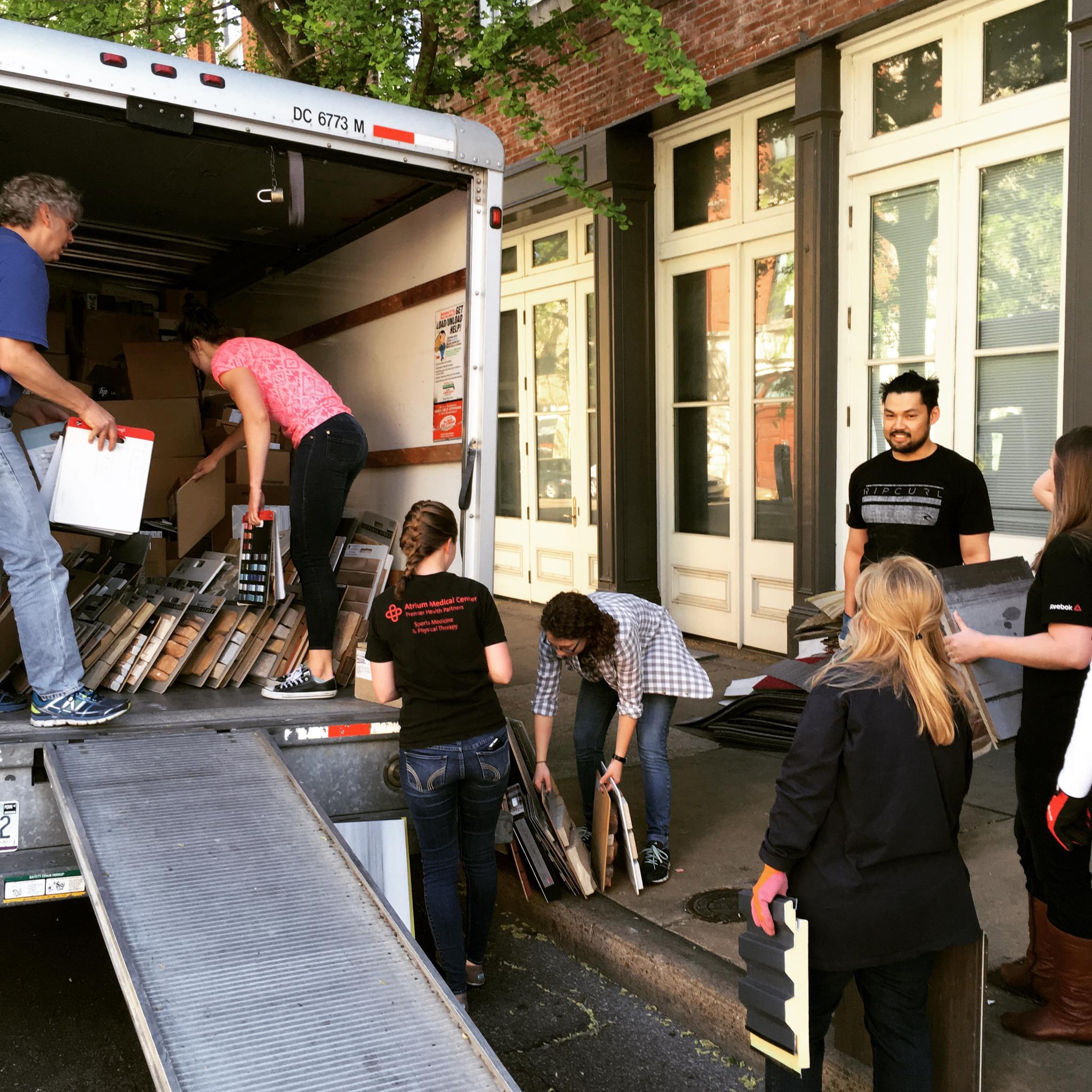Casino Style: Dike Bacon Weighs in on “Making Money Beyond the Casino Floor”
"The challenge is not to define products that appeal to one audience or another, but to take cues from all generational perspectives and customer demands, and incorporate them in new and exciting ways."
Dike Bacon, Principal, HBG Design, as quoted in Casino Style magazine
TO READ THE FULL ARTICLE, CLICK HERE.
HBG's Dike Bacon Weighs in on the Evolution of Indian Gaming
http://issuu.com/hnedakbobogroup/docs/diversity_by_design?e=3030867/34707596
HBG’s Emily Marshall, IIDA, designs ‘A Place to Dine’
Excerpt from HBG’s article, ‘A Place to Dine: Food and Beverage Design’

Inside the most celebrated resort food and beverage venues, it is the innovation and creativity of the design—not merely the savory culinary selections—that elevate the dining experience to amazing heights of epicurean delight.
Restaurant design trends are shifting to consider not only the visual presentation of the space but also the emotional reactions and special interests of the guests—and one size (or theme) does not fit all. Staying abreast of restaurant design trends means staying abreast of retail trends, influences in fashion and entertainment, F&B operations, consumer behavior and market competition. At HBG, our interior designers are researchers and market surveyors. They are keeping an eye on where popular culture is headed, which often informs how hospitality and F&B design will evolve to meet new demographics.
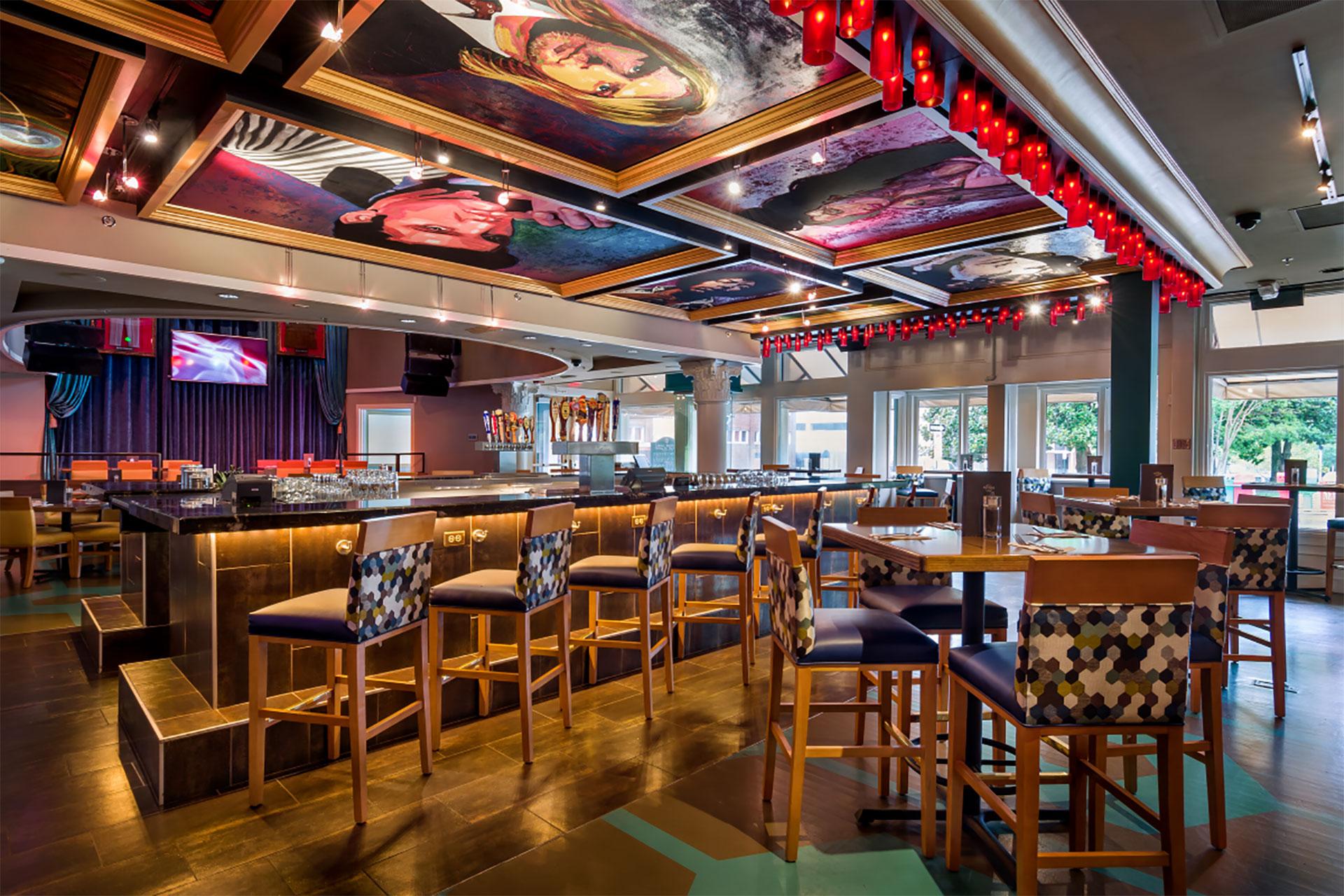
New market segments, i.e. millennials, are shifting the emphasis in entertainment design to include special events and unique experiential dining opportunities which also bring in the local crowd. Sports bars, specialty cigar bars, farm-to-table-inspired restaurants, and even food-as-theater dining venues are popular with the younger, often more design-minded population seeking unique or artistic design “moments” to share with their social media networks, specifically via Instagram and Twitter.
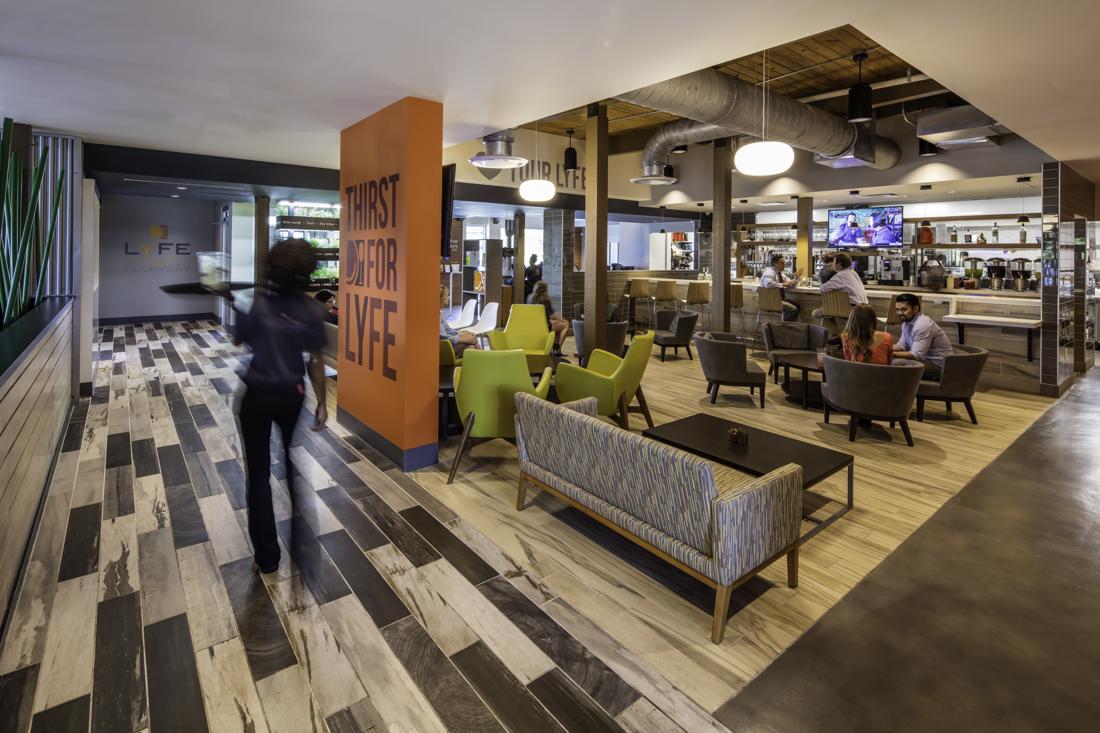
Restaurant design trends typically vary greatly depending on the target market. With a strong knowledge of national F&B design trends, our team approaches each design project holistically to create an end product that delivers an all-encompassing culinary experience for each market with the goal of providing an unsurpassable dining experience that maximizes operational efficiency for the Owner. Each space must work for the guest, while providing flexibility and effectiveness for staff and servers.
Every aspect of the food & beverage process is considered, beginning with understanding the venue’s overall food concepts and the F&B manager’s operational ideals. HBG interior designers develop an overall design plan including dining room interior solutions, kitchen design solutions, lighting and acoustics. To meet technology needs, many F&B outlets are now using iPads to showcase menu options. This translates into thoughtfully designed furniture with charging stations, and an audio-visual package that offers streaming from personal handheld devices.
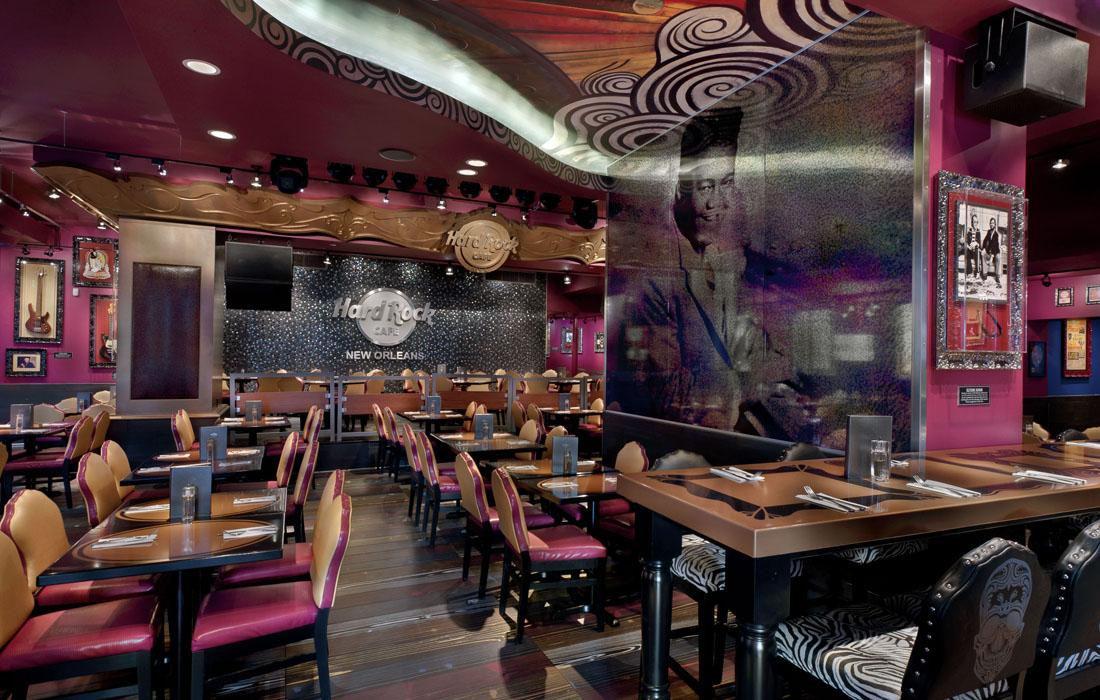
An immersive F&B design experience often transcends physical space to inform branding as an intrinsic part of the experience – logo design, menu graphics, tabletop selections, artwork, marketing collateral, and staff uniforms – all contributing to the customer’s total dining experience. With a variety of options at their fingertips, today’s guest has HIGH expectations.
HBG Principal Dike Bacon Joins a Roundtable Discussion on Non-Gaming Amenities at Casino Properties
Each year, Casino Design magazine gathers a group of experts in the field to talk about issues that impact their discipline. For this year’s edition, moderator Julie Brinkerhoff Jacobs, the president and chief financial officer of Lifescapes International, Inc., focuses on the crucial subject of non-gaming amenities.
With gaming revenues flat or declining in an increasingly competitive industry, casino resorts are struggling to decide what non-gaming amenities their guests would prefer and what brings the biggest bang for the buck. So sit back and learn how your property can tap into this lucrative market.
The faculty for this year’s roundtable includes:
• Dike Bacon, Principal, Development Leader/Director of Planning and Business Development, Hnedak Bobo Group
• DeRuyter Butler, Executive Vice President of Architecture, Wynn Design & Development
• Rich Emery, President & Design Principal, Thalden Boyd Emery Architects
• Paul Heretakis, Vice President, Westar Architects
• Tom Hoskens, Vice President, Founding Principal, Cuningham Group
• Bob Kelly, Senior Vice President-Pre-Construction, Roy Anderson Construction
• Andrew Kreft, Executive Senior Principal / Director of Design, Lifescapes International, Inc.
• Patrick Murphy, President, Pechanga Development Corporation
• Stephen Ranck, Southwest Hospitality Practice Area Leader, Gensler
• Richard (Dick) Rizzo, Vice Chairman, Tutor Perini Building Corp.
• Paul Steelman, CEO, Steelman Partners
King Suite at Four Winds New Buffalo Casino Resort
What does a hotel do for a casino, both in terms of visitations and revenue?
BACON: A hotel speaks to the notion of a resort experience more than any other amenity (golf not withstanding) and is often the primary component of a true integrated resort, which is fancy term for mixed-use development. No other amenity contributes to longer length of stay than a hotel. F&B patronage is significantly stronger with an overnight guest. The fundamental key for success, however, is recognizing that you’re not in the hotel business but the gaming resort business.
Meetings and conventions are a fast-growing part of most resorts. What are the secrets of adding a successful meetings and convention business?
Winstar World Casino Resort
BACON: The meetings and convention business have become extremely competitive, but can be a great non-gaming revenue generator. The average meeting attendee will book an early week room night and use an expense account to spend generously on F&B. One of the biggest contributors to incremental revenue success is the proper promotion of the space to the right groups. It’s no secret that the typical meeting attendee is an average gamer, so it’s critical to market to the right meeting planners in order to land the right demographics.
See the full roundtable discussion in the 2015 Casino Design Magazine
Design by Evolution: How to Maximize and Reinvent Every Space in Your Existing Casino
“For many gaming tribes across the country, a challenge is not trying to figure out what to new-build next (unless market opportunities and demand warrant), but how to aggressively maximize or reinvent every square foot of existing space,” says Dike Bacon, principal for the Memphis-based Hnedak Bobo Group, which has a rich tradition with tribal gaming projects.

HBG Principal and Industry Expert, Dike Bacon
“Many larger, older facilities were designed and built during times when excess or underutilized space was of no consequence,” Bacon says. “Public spaces, lobbies, casino floors, guest rooms, and many backs of houses were huge simply because they could be, and they got financed. There are always plenty of opportunities to renovate and refurbish, but often the biggest opportunity to directly affect the bottom line is to adaptively repurpose these kinds of inefficient existing spaces into new non-gaming revenue generators and entertainment experiences.”
The changes don’t always have to entail bells and whistles. They can be subtle.
“Things don’t have to be overcomplicated,” Bacon says. “Maybe inject some old-school glamour and turn an oversized lobby into an elegant, multi-dimensional entertainment space. Or turn an underutilized back-of-house space adjacent to an existing kitchen into a cutting-edge, chef-driven fast-casual. Move poorly located and off-trend bars to higher-profile, more socially interactive locations or reposition and redesign retail outlets for maximum storefront and product exposure.
“If gaming revenues stay relatively flat, the bottom-line impact of reinventing or discovering new non-gaming amenities that are properly positioned relationally inside an existing building envelope can be significant.”
An evolving trend in the regional gaming industry is the whole notion of not trending out, Bacon contends. This can be accomplished by capitalizing on the experiential travel economy in unique ways.
“A classic problem is that virtually everything new or on trend at some point becomes stale and has to be reinvented,” he says. “The best success is often found by tailoring the new offerings to the local guest in an aspirationally classic way, while not delivering something unfamiliar or out of bounds.
Residually, this locavore-type product can be a draw and can often dramatically extend geographic reach.
“This is the sort of thing an experiential traveler seeks out—a contextual, localized experience that can’t be found or easily replicated somewhere else. It’s actually the exact opposite of a replicated brand standard, and can be a great way to expand a customer base. Indian casinos, because they are often individual and authentic anyway, are tailor-made for this.”
The Seneca Buffalo Creek casino expansion illustrates a property knowing what works. A $40 million expansion, modest but meaningful in today’s market, includes a two-story expansion project, a new high-limit game room, 360 additional slot machines and 10 game tables, bringing the total number of slot machines to 1,200 and game tables to 32 after construction.
The expansion will also create a new retail area and add a small performance stage for live entertainment at the Stixx Sports Bar. The existing Buffalo Savors Grill will be upgraded, and a second floor will house a new restaurant, the Western Door Steakhouse, which is one of the most popular restaurants at Seneca Gaming’s other New York casino properties. Construction will be complete in early 2017.
See the full article on “Design By Evolution” in the 2015 Casino Design Magazine
A Three Step Plan to a Millennial-Ready Casino
By Danny Valle, AIA, Principal, Hnedak Bobo Group
You have a thriving regional casino operation and loyal gaming customers. Baby Boomers have been your bread and butter demographic for years. Now you are wondering how to reach the millennial generation, when article after article tells you that millennials do not prefer slot machines–but your main revenue source has typically come from slot gamers. So, where do you start and how soon do you need to put a plan in place?
Now in their 20s to mid 30s; millennials are major brand influencers. Numbering 80 million+ strong with entertainment dollars to spend, there is no denying that this social, tech-savvy younger generation is spurring the evolution of entertainment—and the design of regional casinos and casino resorts.
But, how do you begin to align your entertainment offerings with millennial consumer preferences?
Only by understanding the values important to millennials can you begin to capture this prolific market segment. Start by elevating your focus on social technology, targeted amenities, and authentic and unique design.
1) Build an online social presence that meets Millennials face-to-face.
With 71% of millennials using social technology every day, your first contact with this generation is likely to occur online. So, start by developing a well-designed social technology program that complements their preferred communication style.
Research tells us that this generation uses social media like a second brain, to vet new brands, cultivate relationships and communicate their preferences to their extensive online networks.
“Millennials, in particular, are seekers of information, and they make informed decisions knowing there are a tremendous number of options available to them,” says Rich LeBaron, Director of Emerging Technologies at Sycuan Casino outside of San Diego, California.
“If the information they are seeking is difficult to consume quickly, they will be turned off and move on to other options,” adds LeBaron. To enhance its online customer service, Sycuan Casino strengthened its social media communication on Twitter and Facebook, and has leveraged cutting edge cloud technologies to design and develop the gaming industry’s first truly engaging and responsive mobile application for Iphone and Android users.
The app provides quick and easy access to important information about entertainment events, dining options, personal club accounts and allows patrons to participate in exclusive offers and rewards. “We are consistently told by our customers that our new phone app is a major driver in where they decide to game,” adds LeBaron.
Imagery and design speaks volumes to millennials. Sycuan’s social technology sites feature lifestyle images showing guests of all demographics enjoying the property’s amenities. “Presenting and conveying information through imagery and short to the point text is absolutely critical to engaging millennials online,” says LeBaron. “Web pages should be telling stories from top-to-bottom to keep customer engagement high.”
2) Connect your amenities to the personal interests of Millennials.
Research tells us that millennials are driven to cultivate experiences that enhance their lifestyles. They are not lured my money or materialism. But they will spend money on entertainment if provided with creative amenity options that support their social interests and their personal brands.
Having grown up in a world addicted to the Food Network and ESPN, millennials are gravitating toward food-centric and sports-centric venues. Local healthy eating / farm-to-table dining, wine tasting, craft beer brewing, live sports and fantasy sports; millennials are elevating these activities to an entertainment-driven art form.
These activities also provide ‘Instagram-able’ moments to share with their online social networks. And, smart design of these venues incorporates ample lounge areas conducive to gathering and lingering, resulting in increased F&B revenues for owners.
Because of millennial influences, casino operators are rethinking the guest experience, transforming casino properties into amenity-rich entertainment destinations.
“We want to become a complete entertainment destination for customers in our region,” says Leo Culloo, General Manager at The Point Casino in Kingston, Washington, owned by the Port Gamble S’Klallam Tribe. “Because millennials are so highly diverse in their entertainment preferences, we host multiple unique events throughout the week to balance the distinct needs of our customers.”
The Point Casino hauls in truck-loads of sand for their popular Spring Break Beach Party concert series, and offers regular wine tasting events, a cigar lounge, and outdoor kitchen and dining amenities, among others, in response. “We are also building more open indoor and outdoor gathering amenities including an outdoor kitchen into our new hotel to provide the flexible space needed to accommodate our social events,” adds Culloo.
“Here at Sycuan, we know millennials aren’t always visiting us to gamble,” says LeBaron. “It’s imperative to connect them with our other amenities and entertainment options; and our GameDay Sports Bar is one of the best in all of San Diego.”
And, for a tech savvy demographic, convenience is likely the most appreciated amenity. The Point Casino later this fall will be testing integrated tablet devices at each gaming machine in its casino. “The tablets will give patrons the autonomy and convenience to instantly order food and drinks, delivered right to the guest on the gaming floor,” says Culloo.
3) Give Millennials the open, authentic design experiences they crave.
Surveys show that design matters to millennials. Because they are highly visual consumers, they use design to filter their entertainment choices. This means that design targeted to millennials must be authentic (and hip and cool) to be effective.
With designs that integrate heritage, culture and local context, Indian Tribes have a great opportunity to offer millennials authenticity of experience.
For example, The Point Casino is developing a simple, modern design aesthetic for its new hotel on the northern Kitsap Peninsula of Washington State. Complementing the natural coastal beauty and the tribe’s native heritage, the property will integrate authentic, impactful tribal motifs and indigenous materials as design details. “Under the guidance of a tribal art committee and our design team, local artisans are reimagining elements of tribal culture in the hotel’s exterior and interior design, including artwork, totem carvings, sculptures and etchings,” says Culloo.
Tribal clients are exploring how culture and history can engage millennials, by melding design, cultural education and entertainment experiences.
From a functional design standpoint, operators and designers are examining how millennials utilize space. They typically won’t patronize difficult to navigate environments. When Sycuan Casino modernized its casino a couple years ago, it visually opened up the entire gaming floor, eliminating barriers to transparency and convenience. Slot machines were placed prominently to accommodate Sycuan’s main customer base, but site lines were opened to other diverse amenities, including the GameDay Sports Bar, to attract new demographics.
Technology is an important factor in public space design. Because customers need dedicated spaces to use cell phones, laptops and personal devices, designers are integrating more soft seating areas, lounges and bar height worktops to accommodate passive social activities, with convenient access points to outlets and charging stations.
Start now and elevate your casino design by tapping into the preferences of these young adults. By focusing your resources and budget where they will matter most your property will be positioned for long-term marketability.
See article in this month’s Indian Gaming magazine
Your Three Step Plan to a Millennial-Ready Casino
By Danny Valle, AIA, Principal, HBG Design
As published in Indian Gaming magazine, September 2015
You have a thriving regional casino operation and loyal gaming customers. Baby Boomers have been your bread and butter demographic for years. Now you are wondering how to reach the millennial generation, when article after article tells you that millennials do not prefer slot machines-but your main revenue source has typically come from slot gamers. So, where do you start and how soon do you need to put a plan in place?
Now in their 20’s to mid 30’s; millennials are major brand influencers. Numbering 80 million+ strong with entertainment dollars to spend, there is no denying that this social, tech-savvy younger generation is spurring the evolution of entertainment—and the design of regional casinos and casino resorts.
But, how do you begin to align your entertainment offerings with millennial consumer preferences?
Only by understanding the values important to millennials can you begin to capture this prolific market segment. Start by elevating your focus on social technology, targeted amenities, and authentic and unique design.
1) Build an online social presence that meets Millennials face-to-face.
With 71% of millennials using social technology every day, your first contact with this generation is likely to occur online—so, start by developing a well-designed social technology program that complements their preferred communication style.
Research tells us that this generation uses social media like a second brain, to vet new brands, cultivate relationships and communicate their preferences to their extensive online networks.
"Millennials, in particular, are seekers of information, and they make informed decisions knowing there are a tremendous number of options available to them," says Rich LeBaron, Director of Emerging Technologies at Sycuan Casino outside of San Diego, California.
"If the information they are seeking is difficult to consume quickly, they will be turned off and move on to other options," adds LeBaron. To enhance its online customer service, Sycuan Casino strengthened its social media communication on Twitter and Facebook, and has leveraged cutting edge cloud technologies to design and develop the gaming industry’s first truly engaging and responsive mobile application for Iphone and Android users.
The app provides quick and easy access to important information about entertainment events, dining options, personal club accounts and allows patrons to participate in exclusive offers and rewards. "We are consistently told by our customers that our new phone app is a major driver in where they decide to game," adds LeBaron.
Imagery and design speaks volumes to millennials. Sycuan's social technology sites feature lifestyle images showing guests of all demographics enjoying the property’s amenities. "Presenting and conveying information through imagery and short to the point text is absolutely critical to engaging millennials online," says LeBaron. "Web pages should be telling stories from top-to-bottom to keep customer engagement high."
2) Connect your amenities to the personal interests of Millennials.
Research tells us that millennials are driven to cultivate experiences that enhance their lifestyles. They are not lured my money or materialism. But they will spend money on entertainment if provided with creative amenity options that support their social interests and their personal brands.
Having grown up in a world addicted to the Food Network and ESPN, millennials are gravitating toward food-centric and sports-centric venues. Local healthy eating / farm-to-table dining, wine tasting, craft beer brewing, live sports and fantasy sports; millennials are elevating these activities to an entertainment-driven art form.
These activities also provide ‘Instagram-able’ moments to share with their online social networks. And, smart design of these venues incorporates ample lounge areas conducive to gathering and lingering, resulting in increased F&B revenues for owners.
Because of millennial influences, casino operators are rethinking the guest experience, transforming casino properties into amenity-rich entertainment destinations.
“We want to become a complete entertainment destination for customers in our region,” says Leo Culloo, General Manager at The Point Casino in Kingston, Washington, owned by the Port Gamble S’Klallam Tribe. “Because millennials are so highly diverse in their entertainment preferences, we host multiple unique events throughout the week to balance the distinct needs of our customers."
The Point Casino hauls in truck-loads of sand for their popular Spring Break Beach Party concert series, and offers regular wine tasting events, a cigar lounge, and outdoor kitchen and dining amenities, among others, in response. "We are also building more open indoor and outdoor gathering amenities including an outdoor kitchen into our new hotel to provide the flexible space needed to accommodate our social events," adds Culloo.
"Here at Sycuan, we know millennials aren’t always visiting us to gamble," says LeBaron. "It’s imperative to connect them with our other amenities and entertainment options; and our GameDay Sports Bar is one of the best in all of San Diego."
And, for a tech savvy demographic, convenience is likely the most appreciated amenity. The Point Casino later this fall will be testing integrated tablet devices at each gaming machine in its casino. “The tablets will give patrons the autonomy and convenience to instantly order food and drinks, delivered right to the guest on the gaming floor,” says Culloo.
3) Give Millennials the open, authentic design experiences they crave.
Surveys show that design matters to millennials. Because they are highly visual consumers, they use design to filter their entertainment choices. This means that design targeted to millennials must be authentic (and hip and cool) to be effective.
With designs that integrate heritage, culture and local context, Indian Tribes have a great opportunity to offer millennials authenticity of experience.
For example, The Point Casino is developing a simple, modern design aesthetic for its new hotel on the northern Kitsap Peninsula of Washington State. Complementing the natural coastal beauty and the tribe’s native heritage, the property will integrate authentic, impactful tribal motifs and indigenous materials as design details. “Under the guidance of a tribal art committee and our design team, local artisans are reimagining elements of tribal culture in the hotel's exterior and interior design, including artwork, totem carvings, sculptures and etchings,” says Culloo.
Tribal clients are exploring how culture and history can engage millennials, by melding design, cultural education and entertainment experiences.
From a functional design standpoint, operators and designers are examining how millennials utilize space. They typically won’t patronize difficult to navigate environments. When Sycuan Casino modernized its casino a couple years ago, it visually opened up the entire gaming floor, eliminating barriers to transparency and convenience. Slot machines were placed prominently to accommodate Sycuan’s main customer base, but site lines were opened to other diverse amenities, including the GameDay Sports Bar, to attract new demographics.
Technology is an important factor in public space design. Because customers need dedicated spaces to use cell phones, laptops and personal devices, designers are integrating more soft seating areas, lounges and bar height worktops to accommodate passive social activities, with convenient access points to outlets and charging stations.
Start now and elevate your casino design by tapping into the preferences of these young adults. By focusing your resources and budget where they will matter most your property will be positioned for long-term marketability.
'Five Ways Your Casino Design Can Pay You Back', as appeared in Indian Gaming magazine
In today's post recession economy, the advent of next generation consumers, the 'millennial effect' and increased market competition are heavily influencing the gaming industry’s bottom line. Every budgetary dollar is scrutinized and many gaming operators are looking for economic and marketing advantages, seeking untapped methods for maximizing returns on their design, construction and operational investments.
There is an economic strategy that could potentially save a gaming operation hundreds of thousands of dollars each year, while improving the environmental standard for casino guests – sustainability. While not a new term or idea, the implementation of sustainability initiatives could become the essential strategy needed to protect your gaming interests and revenue share.
Defining Sustainability
In this context, sustainability can be defined as ‘Environmental stewardship through good decision-making and efficient casino design as translated into potential cost savings.’ The formula has been proven, and gaming enterprises must begin by elevating internal perceptions about the value of sustainability if they are to receive all the associated cost benefits and advantages to be derived from sustainable initiatives. But how do you translate 'sustainability' into your program for full effect, and can you trust that 'sustainability' will actually pay back?
Some within the gaming industry have made significant strides at rebranding their corporate values toward sustainability. Operators such as Ho-Chunk Gaming, the Tohono O'odham Nation and Caesars Entertainment have shown significant confidence in the form of companywide 'green' programs and/or in registrations for sustainable certifications. The Caesars Horseshoe Casino in Baltimore recently achieved LEED Gold certification, a testament to their efforts and commitment to environmental business practices.
This signals a growing trend in the gaming industry where environmental stewardship is becoming more prevalent within the owner’s design, construction and operational goals, especially when it aligns with corporate objectives and positively impacts ROI – a model heralded by John Elkington's 'Triple Bottom Line: people, planet and profit" concept.
Not sure how to start integrating sustainable programs at your casino? Whether you are designing a new property or renovating your existing operation, it's not too late to receive economic benefits. Following are five suggestions on where to start to see the biggest return on investment.
Energy Efficiency
According to the U.S. Department of Energy and the U.S. Green Building Council, buildings, by sector, are one of the heaviest consumers of natural resources at 41%. Of that, the majority of that energy consumption comes from a building’s lighting, followed by space heating and space cooling.
1) Establish energy conservation goals. Setting achievable goals and committing to them as part of your company's core values can be a very powerful tool in maintaining your financial objectives. A goal of 1% or 2% energy reduction annually can amount to significant savings over time. Set small goals initially to make sure they are, in fact, achievable. The inertia generated from each little victory will add up, and before you know it, you are well on your way to meeting, and most likely exceeding your long term goals.
2) Re-commission your existing facility. As technology improves and existing equipment ages and loses efficiency, have your existing HVAC systems re-commissioned. This activity could help you avoid the need for new or additional equipment, thus resulting in net capital savings. Re-commissioning can help you implement numerous cost effective strategies to reduce your heating, cooling and electrical loads. Also, upgrade your current light fixtures. Of the aforementioned 40% energy consumption, lighting can account for roughly 25% of that overall demand. For example, florescent lights with electronic ballasts are about 12% more efficient than conventional magnetic ballasts. According to the University of Michigan Department of Occupational Safety and Environmental Health, fixtures with electronic ballasts can result in a 5%-10% space cooling cost reduction, due to the amount of heat generated by the lights.
3) Design for performance. Leveraging performance-based whole-building analysis during the early stages of design can help optimize the building envelope, building site orientation and energy efficiency, typically resulting in reduced mechanical equipment size. Performance-based analysis allows for refinement and optimization of your building providing a potential for first cost reduction followed by decreased operating costs.
Energy modeling is an effective tool that allows an architect to conduct cause and effect studies on multiple design iterations, and helps to align the owners sustainable, programmatic and aesthetic goals with the overarching fiscal goal. Design impacts can be identified early and decisions made to mitigate potential unnecessary first costs or operating costs by evaluating fluctuation in energy demand. Imagine saving 50 tons of cooling load with 1 ton costing approximately $2,500. That’s a potential realized savings on equipment alone of $125,000 depending on the trade-off taken to achieve it.
Water Conservation
Water conservation can contribute significantly to your economic goals; whether its first costs on new construction or operational cost for an existing property, lowering water usage saves money and will help to extend the life of existing supply and wastewater facilities.
4) Use less. Water conservation is as much about retraining habits as it is about using highly efficient plumbing fixtures. The largest uses of water in hotels are restrooms, laundry operations, landscaping and kitchens. By using high efficiency toilets, shower heads, and faucet aerators you can use 20% less water than conventional models.
According to the EPA, operating costs and environmental impacts are highly influenced by water use. Industry estimates suggest that implementing water efficient practices in commercial buildings can decrease operating costs by approximately 11 percent, and energy and water use by 10 and 15 percent, respectively.
5) Capture for reuse. Consider taking advantage of your site’s alternative water sources. Depending on your level of commitment and/or your cost benefit analysis, utilizing alternative water sources is not for everyone. On-site generated water can vary greatly in quality and should be evaluated carefully for the appropriate use. Potential alternate sources for outdoor water usage/landscaping include: rainwater, foundation drain water, treated gray water and condensate from air handler equipment.
According to the EPA, outdoor water use can account for between 5-30 percent of a facility’s total water use. Using regional, drought tolerant landscaping in conjunction with efficient irrigation systems can provide for significant water savings. The proverbial low hanging fruit in terms of potential infrastructure cost impacts is the use of captured rainwater for irrigation purposes. Remember, check with your local ordinances regarding capturing rainwater since there may be restrictions on water rights, as there are in California.
Consider each method presented above, and start tallying your savings – the returns add up fast; and this is far from an exhaustive list of sustainable methods available (waste diversion tactics in both construction and operations also offer a high return rate). Become informed about the sustainable advantages. Rescued revenues can contribute to reinvestment programs for existing facilities or investment in community building. Remember, good companies stick to their values; great companies question and challenge their values regularly.
HBG Design Helping Schools, Community Through Green Initiatives
Memphis, Tenn. – Memphis architecture firm HBG Design just completed interior design work on an office building on International Place in East Memphis, which is a LEED-registered project. HBG designed the 9-story, 225,000 square feet building’s interior to be as green as possible, focusing on several green design aspects, including maximizing the use of natural light and selecting products that are manufactured from sustainable resources and that contribute to healthy indoor environments.
But when it comes to looking out for the environment, HBG goes well beyond sustainable building practices. This month, the firm is organizing a local effort with ZeroLandfill and the International Interior Design Association (IIDA) that takes leftover carpet samples, wall coverings, tiles and other design leftovers and donates them to schools, humane societies, artists, families and organizations across the area. The general public will be able to pick-up these materials at two events on Saturday, April 18th, and Saturday, April 25th.
This is the third year HBG has taken part in the ZeroLandfill drive. Since then the firm has taken on a leadership role in organizing the event and encouraging other firms and designers to think about what they can donate throughout the entire year.
“The day after last year’s donation, we started storing the products for this year’s drive and now we are busting at the seams (see photo),” said HBG designer and Memphis IIDA director, Alexandra Campbell. “Last year, we kept 9,000 pounds of these design leftovers out of local landfills, and this year we expect even more. We can all really make a difference in this community by always thinking green.”
The ZeroLandfill drive is only one small part of HBG’s overall efforts. Just last month, HBG donated carpet tiles to a middle-Tennessee daycare for low-income families, providing a safer and more vibrant play area for the children there.
All of this is part of HBG’s HBGreen initiative, developed to encourage its clients to embrace sustainable building practices and to reduce the firm’s own carbon footprint. Sustainability is integrated, where feasible, into every project as well as into HBG’s daily operations. Outside the application of green building concepts to design, HBGreen’s internal goals are to achieve LEED accreditation for half of the HBG workforce-- right now about 20 percent are LEED accredited; and to modify its offices and employee behaviors to reduce consumption of resources and integrate sustainable options.
The timeline on all of this is aggressive. HBG is looking for full integration of these practices within five years. The firm hopes leading by example will encourage others in this area to make sustainability a part of their everyday operations, improving our community along the way.

